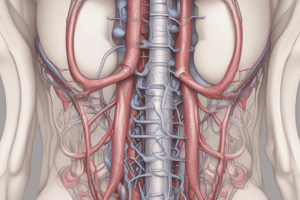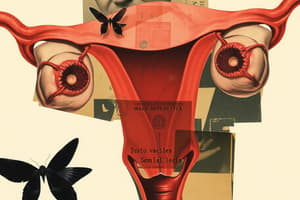Podcast
Questions and Answers
What is the liquid component of the ejaculate produced by several glands during sexual stimulation or orgasm?
What is the liquid component of the ejaculate produced by several glands during sexual stimulation or orgasm?
- Seminal fluid (correct)
- Prostate gland secretions
- Bulbovaginal secretion
- Sperm cells
Which gland contributes around one-third of the volume of seminal fluid?
Which gland contributes around one-third of the volume of seminal fluid?
- Bulbourethral glands
- Seminal vesicles
- Testes
- Prostate gland (correct)
What is the role of zinc and other minerals in epididymal secretions?
What is the role of zinc and other minerals in epididymal secretions?
- Enhance sperm motility and fertility (correct)
- Prevent sperm maturation
- Decrease sperm cell lifespan
- Increase sperm cell size
What do the bulbourethral glands produce to help lubricate the urethra?
What do the bulbourethral glands produce to help lubricate the urethra?
Where does the vas deferens transport sperm cells and seminal fluid to?
Where does the vas deferens transport sperm cells and seminal fluid to?
What is the function of fructose in seminal fluid?
What is the function of fructose in seminal fluid?
Which fluid component neutralizes the acidic conditions found within the female genital tract?
Which fluid component neutralizes the acidic conditions found within the female genital tract?
What happens to cervical mucus during ovulation?
What happens to cervical mucus during ovulation?
What is a key role of the seminal vesicles in producing seminal fluid?
What is a key role of the seminal vesicles in producing seminal fluid?
How do the nutrients in seminal fluid contribute to the fertilization process?
How do the nutrients in seminal fluid contribute to the fertilization process?
Which glands produce the fluids that contribute to seminal fluid?
Which glands produce the fluids that contribute to seminal fluid?
What is the primary function of seminal fluid in relation to sperm cells?
What is the primary function of seminal fluid in relation to sperm cells?
Flashcards are hidden until you start studying
Study Notes
Seminal Fluid: Composition and Function
The male reproductive system plays a crucial role in reproduction through producing sperm cells. Seminal fluid is the liquid component of the ejaculate produced by several glands during sexual stimulation or orgasm. This fluid serves multiple functions that facilitate successful fertilization.
Prostate Gland Secretions
The prostate gland contributes around one-third of the volume of seminal fluid. It produces alkaline fluids that neutralize acidic conditions found within the female genital tract, which may otherwise harm the sperm's structure and motility. This alkalinity also enhances the chances of sperm survival in the vagina. Moreover, the prostate gland provides nutrients to strengthen the sperm cells.
Bulbourethral Glands
These two small glands located near the base of the penis produce a tiny amount of mucus-like fluid called bulbovaginal secretion. This substance contains various minerals and proteins that help lubricate the urethra and protect sperm cells from the acidic environment of the female genital tract.
Seminal Vesicles
The seminal vesicles contribute to seminal fluid by producing fructose for energy and proteins that contribute to sperm motility. Fructose is important for sperm cells to move efficiently through the female reproductive tract. Additionally, the seminal vesicles secrete a small amount of fluid that helps thin the seminal fluid and enhance its movement.
Epididymis
The epididymis is a coiled tube inside the scrotum, where sperm cells mature after leaving the testicles. During this maturation process, epididymal secretions, including zinc and other minerals, enter the sperm cells. These substances are essential for sperm motility and fertility.
Vas Deferens
The vas deferens is a muscular tube connecting the epididymis to the seminal vesicles and prostate gland. It transports sperm cells and seminal fluid from these glands to the urethra, where they mix to form the ejaculate.
Cervical Mucus
Although not a part of the male reproductive system, cervical mucus is an essential component of the fertilization process. It is produced by the cervix and helps facilitate the movement of sperm cells through the female reproductive tract. During ovulation, cervical mucus becomes more fluid and alkaline, which allows sperm cells to pass through more easily.
In summary, seminal fluid is a complex mixture of fluids produced by various glands that aid in the successful fertilization of an egg. The alkaline environment, nutrients, and minerals found within seminal fluid help protect and support the sperm cells on their journey to fertilize an egg.
Studying That Suits You
Use AI to generate personalized quizzes and flashcards to suit your learning preferences.



